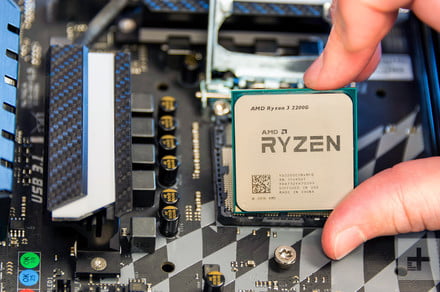AMD’s upcoming Ryzen 3000-series CPUs could offer as many as 16 cores and 32 threads to consumers, with the most powerful of chips hitting turbo frequencies as high as 5.1GHz. If that rumor proves true, it would make AMD’s next-generation CPUs an exciting option for new buys and upgrades in 2019, especially if Intel continues to face problems with its next-generation Cannon Lake 10nm chips.
The existing Zen and Zen+ Ryzen CPUs have proved incredibly impactful in the PC industry. They blazed a trail that Intel has since matched, offering six-core and eight-core CPUs to mainstream consumers at affordable prices. And they closed the performance gap in instructions per clock between AMD and Intel CPUs even further. The third-generation of Ryzen CPUs, however, could continue that trend and if the latest rumors are accurate, could eliminate the gap entirely, or even swing the pendulum of performance in AMD’s direction.
These should be taken with a pinch of salt, as this rumor comes straight from anonymous sources that cannot be verified, via YouTuber AdoredTV. We have heard a lot of suggestions of great performance gains with the next-generation Ryzen CPUs though, so these specifications aren’t outside the realm of possibility.
They suggest that the Ryzen 3000 series will be a lot busier than the current Ryzen 2000 series, with more chips, and more specific performance sectors.
CPU
Cores/Threads
Base clock
Turbo clock
TDP
Price
Ryzen 3 3300
6/12
3.2Ghz
4.0GHz
50w
$99
Ryzen 3 3300X
6/12
3.5GHz
4.3GHz
65w
$129
Ryzen 3 3300G
6/12
3.0GHz
3.8GHz
65w
$129
Ryzen 5 3600
8/16
3.6GHz
4.4GHz
55w
$178
Ryzen 5 3600X
8/16
4.0GHz
4.8GHz
95w
$229
Ryzen 5 3600G
8/16
3.2GHz
4.0GHz
95w
$199
Ryzen 7 3700
12/24
3.8GHz
4.6GHz
95w
$299
Ryzen 7 3700X
12/24
4.2GHz
5.0GHz
105w
$329
Ryzen 9 3800X
16/32
3.9GHz
4.7GHz
125
$449
Ryzen 9 3850X
16/32
4.3GHz
5.1GHz
135w
$499
The naming scheme for each chip is borrowed from existing generations of Ryzen CPUs. The “X” chips offer higher turbo clocks thanks to AMD’s XFR automated overclocking. The “G” chips are actually APUs with bundled Navi graphics cores, according to the rumor.
These rumored specifications suggest that octa-core desktop CPUs could become the norm and 4GHz+ would be commonplace for all CPUs when boosted. Prices remain very comparable to the last generation of Ryzen CPUs, making these chips much more affordable than a lot of Intel’s latest offerings and an easy upgrade choice for existing Ryzen users — especially since these chips should be compatible with existing AM4 motherboards.
According to WCCFtech’s analysis, the Ryzen 7 and Ryzen 9 CPUs listed here are actually built using twin Zen 2 cores linked together. We first saw this “chiplet” approach in AMD’s new Epyc server CPUs, which we were told helped improve the yield of the 7nm parts over traditional big-die designs, which have caused so many difficulties for Intel when shrunk down to sub-12nm sizes.
Most of the chips have analogs in the existing 2000-series generation, but perhaps taking inspiration from Intel’s own Core i9 range, these Zen 2 chips also appear to come in Ryzen 9 3800X and 3850X varieties, offering even higher core counts and clock speeds than the 3700 chips.
The frequencies we see here are comparable to Intel’s ninth-generation chips, but crucially, those tend to only hit those frequencies on a handful of cores at a time unless overclocked. In comparison, Ryzen CPUs tend to turbo boost on all cores, so we may be looking at the first native 5GHz+ CPU across more than 10 cores out of the box.
TDP demands aren’t too wild either. If they prove accurate, as opposed to the overly conservative numbers quoted by Intel for its 9900K and similar ninth-generation CPUs, AMD could steal the efficiency crown and the performance crown in one fell swoop, at a more competitive price.
This is all rosy thinking that makes for fantastic press for AMD, but isn’t based on anything we can guarantee will come to pass. It backs up earlier rumors of big gains in instructions per clock of the new 3000-series, but until we see some screenshots or hear real release numbers from AMD, it’s important to retain some measure of skepticism. The hype train hasn’t left the station yet, but it is looking very well fueled.
Editors’ Recommendations
- Ryzen shine! AMD’s next CPUs could beat Intel at gaming in 2019
- AMD Navi graphic cards could offer RTX 2070-like performance for $250
- AMD Ryzen will add two budget CPUs, gaming-oriented update October 29
- Intel denies rumors that 10nm Cannon Lake CPUs have been canned
- The best processors for gaming

